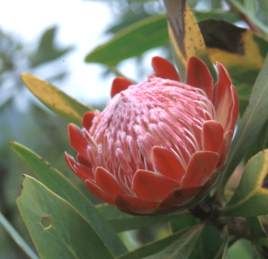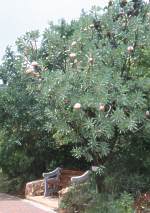Protea caffra
Protea caffra Meisn.
Family: Proteaceae
Common names: sugar bush (English); gewone suikerbos (Afrikaans); isiQalaba (Zulu, Xhosa)
SA Tree No: 87
Introduction
The common sugar bush is one of three proteas which occur in the Witwatersrand area.

Description
Description
Protea caffra grows as a shrub or small tree with a somewhat rounded crown and is common in the natural areas of the botanical garden. The grey-green leaves are elongated with nearly parallel sides. They are leathery in texture and may be up to 250mm in length.
 The flower heads (which may be mistaken for individual flowers) can be borne singly or in clusters. They reach up to 80 mm in diameter with the outer bracts (resembling petals) varying from reddish to pink or cream in colour. Many tiny, single flowers are clustered together in the flower head. When pollinated each flower forms a small nut which is covered in rich reddish brown hairs.
The flower heads (which may be mistaken for individual flowers) can be borne singly or in clusters. They reach up to 80 mm in diameter with the outer bracts (resembling petals) varying from reddish to pink or cream in colour. Many tiny, single flowers are clustered together in the flower head. When pollinated each flower forms a small nut which is covered in rich reddish brown hairs.

The thick bark has a chunky, corky texture. It protects the mature plant from the fires that are essential to the maintenance of the grasslands in which the common sugar bushes grow. Caterpillars of Capys penningtoni (Pennington's protea) and Capys disjunctus butterflies feed on the flowerbuds.
Distribution and habitat
Distribution description
Protea caffra is the most widely distributed protea in South Africa and may be found in grassland and woodland throughout Gauteng, in parts of KwaZulu-Natal, Lesotho, Northern Province, Mpumalanga, the Eastern Cape as far south as the Katberg mountains, and in Zimbabwe. It is usually found growing in large colonies especially on rocky ridges.
Derivation of name and historical aspects
History
The genus is named for the Greek sea-god Proteus who could change into many different shapes. The name refers to the great diversity within the genus. The specific name derives from an old name for eastern and central regions of South Africa, Kaffraria, where the plant originates.
Ecology
Ecology
The copious nectar (from which the plant derives its common name sugarbush) attracts birds and insects such as beetles which pollinate the flowers.
Uses
Use
The bark of Protea caffra is used reportedly used for medicinal purposes.
Growing Protea caffra
Grow
Cultivation has so far proven to be difficult. The germination of seed in cultivation is possible, although transplanting quickly kills the seedlings. Mature sugarbushes in gardens where the original, natural vegetation has been retained also eventually succumb. This may be due to the disturbance of the roots, too much water and sensitivity to fertilisers. It is best to avoid any cultivation around the base of the plant.
Credits
Alice Aubrey
Witwatersrand National Botanical Garden
January 2001
Plant Attributes:
Plant Type: Shrub, Tree
SA Distribution: Eastern Cape, Gauteng, KwaZulu-Natal, Limpopo, Mpumalanga
Soil type: Loam
Flowering season: Early Summer, Late Summer
PH: Neutral
Flower colour: Brown, Green, Red, White, Pink
Aspect: Full Sun
Gardening skill: Challenging
Special Features:
Horticultural zones









Rate this article
Article well written and informative
Rate this plant
Is this an interesting plant?
Login to add your Comment
Back to topNot registered yet? Click here to register.